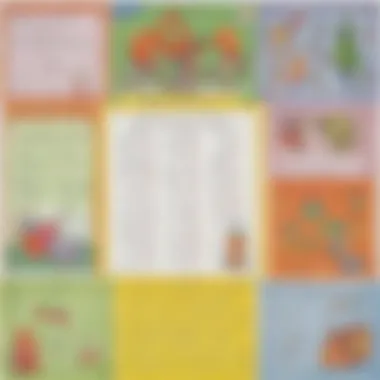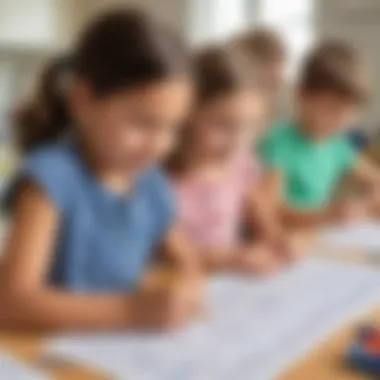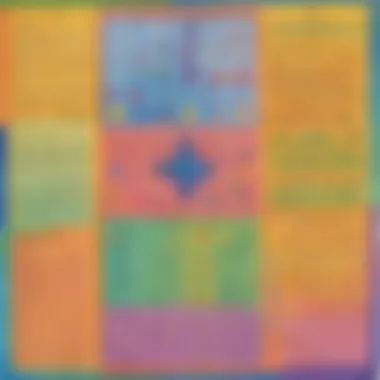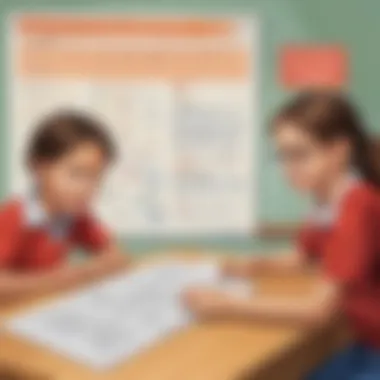Math Worksheets for Second Graders: Boost Learning


Intro
Second grade is a pivotal time for children in their mathematical journey. At this stage, foundational skills such as addition, subtraction, and basic problem-solving become crucial. Teaching these concepts effectively sets the groundwork for future learning. Printable worksheets play a significant role in this educational phase, allowing for both structured practice and creativity. In this article, we will examine various resources available for second graders that enhance their understanding of math through engaging activities, fun quizzes, and informative articles.
Creative Activities
Creative activities stimulate a child's interest while reinforcing crucial mathematical concepts. Hands-on engagement often aids learning in ways that traditional methods do not.
- Craft Ideas: Children can combine math and art by creating designs that involve geometric shapes or symmetry. Projects such as making a math mobile—using string and colored paper cuts into shapes—can incorporate counting and addition as they measure angles and lengths.
- Step-by-Step Guides: Each activity should come with clear instructions. For example, a guide for making a shape collage might outline:
- Educational Value: Completing these crafts fosters fine motor skills and promotes teamwork when done in groups. It is also a subtle way of reinforcing counting and values through non-traditional methods.
- Gather materials: paper, scissors, glue, and markers.
- Choose a theme, like animals or space.
- Cut out various shapes designed for the theme.
- Assemble the shapes on a larger sheet while adding the number of shapes they used.
Fun Quizzes
Quizzes make learning math a bit more interesting. They do not have to be dull, and if designed well, they can create enthusiasm for learning.
- Quiz Topics: On platforms like ElemFun, quizzes cover essential skills like addition and subtraction, telling time, and understanding patterns. The use of themes keeps children more involved.
- Question Types: The variety can include multiple-choice questions, fill-in-the-blank statements, or practical problems that require children to demonstrate their understanding. These varied methods encourage active participation and engagement.
- Knowledge Reinforcement: Frequent quizzes are effective in refreshing knowledge into the children's minds. They serve as checkpoints, solidifying their skills and preparing them for progressively challenging concepts.
Fact-Based Articles
Reading and comprehension are key components of education. Children should develop strong reading habits even as they learn math.
- Topics: Articles can cover an impressive range, such as the history of numbers, how people use math in everyday life, and fun numerical facts.
- Engaging Content: Effective articles present information clearly and simply. visual supports, like charts and pictures, help illustrate concepts while enhancing understanding.
- Additonal Resources: Encouraging further exploration might include links to scholarly articles o external learning sites. References from consistant sources like en.wikipedia.org, or britannica.com will create a deeper context along with enriching the child’s learning experience.
Learning math can be fun and engaging. Using worksheets and activities that tap into various learning styles can significantly enhance understanding and retention.
In closing, integrating printable worksheets that cover creative activities, fun quizzes, and fact-based articles not only essential math skills to line second graders but also instills a love for learning. Providing tools and activities that intertwine education with creativity captures the imagination of young learners and makes mathematical concepts much more relatable.
Understanding the Importance of Math in Second Grade
Math literacy plays a crucial role in second grade education. At this stage, students transition from basic counting to understanding more complex operations and concepts. Recognizing the importance of math during this period aids in the development of analytical thinking, problem-solving skills, and foundational knowledge necessary for advanced studies.
Skills Emphasis: It is important for second graders to familiarize themselves with numbers, decimals, patterns, and basic geometric shapes. Exploring these concepts not only solidifies existing knowledge but promotes confidence in handling practical, everyday math.
Math is also integral in fostering computational fluency. This includes speed and accuracy in addition and subtraction. Engaging students with real-world examples illustrates math applications beyond the classroom. Worksheets serve as great tools in this process.
Additionally, providing students with various resources helps cater to different learning styles. While some pupils excel with visual aids, others thrive through kinesthetic or auditory means. Offering different formats encourages every student to find a pathway that enhances their understanding with little frustration.
A strong emphasis on math skills ensures children are well-equipped as learning progresses. A weakness in numeracy skills can create challenges for students in conceptual subjects. Thus, understanding math facilitates a smoother academic journey going forward, opening doors to enriched learning.
Developmental Milestones in Math
By the second grade, children reach several key milestones in their math understanding. One primary role of this grade is to solidify foundational skills acquired in first grade, providing a springboard for future learning. They develop improved visualization for numbers, allowing for a greater understanding of quantity relationships.
Understanding Larger Numbers: Second graders also start comprehending larger numbers and their value, becoming competent in handling numbers up to 100 or beyond. They understand the concepts of place values, learning how tens and units interact. This setup prepares them for multiplication and more advanced arithmetic operations.
Basic Operational Skills: Addition and subtraction of two-digit numbers is another essential milestone. Children learn strategies like regrouping and borrowing, which strengthens overall problem-solving strategies. They also begin to grasp independent use of math strategies such as estimates and picture representations.
Kids at this stage also delve deeper into geometry, comparing different shapes. They begin recognizing attributes of various shapes -- such as angles and side lengths; this promotes overall spatial reasoning development. In essence, second graders acquire skills that ignite a more complex understanding of numeracy.
Key Math Concepts for Second Graders
Key concepts for second graders extend beyond mere computation to include critical thinking and strategy. At this level, children interact with addition and subtraction in ways that develop an understanding of both terms.
Exploration of Mathematics: Starting with addition and subtraction patterns, students should be comfortable using numbers through a range of worksheets which support visual learning. They should frequently take part in shorter, purposeful practices that enhance cognitive aspects.


Foundations of Multiplication: Introduction to multiplication as repeated addition sets a crucial foundation. Worksheets can display practical language for concepts. Helping students visualize relationships in repeated operations consolidates further learning.
Word Problems and Real-Life Connections: Awareness of real-life applications of math boosts motivation. Engaging word problems related to students' daily experiences fosters ideation. Worksheets act as powerful tools to stimulate relationships between documentation and participants.
Critical fluency in these key concepts facilitates assessment readiness evaluations and builds self-efficacy in students. A deep industry of understanding forms with more confidence, enhancing their mathematical foundation into advanced territory.
The early grasp of math within dynamic activities shapes second graders into resilient mathematics learners.
The Role of Printable Worksheets
Printable worksheets serve as a vital tool in the educational landscape for second graders. They can bridge learning gaps and reinforce fundamental math skills outside traditional instruction methods. In a rapidly digital world, these worksheets offer tactile, hands-on learning experiences that complement online mediums. They not only extend what is taught in the classroom but also engage students in a practical format. In addition, these resources provide a structured way to practice and assess children's understanding of key concepts.
Reinforcement of Core Skills
When children work with printable math worksheets, they are frequently practicing essential skills targeted at their grade level. These core skills include addition, subtraction, and problem-solving strategies. Worksheets help solidify these building blocks by providing students a safe space to make mistakes, learn, and succeed steadily. Repetition is central to mastery in mathematics, and worksheets allow for this repetition in an organized manner.
The consistent practice provided through worksheets can amplify math fluency while boosting children's confidence.
Moreover, regular use of these materials can directly correspond to improving test scores. When children repeatedly face similar problems in different formats, they can gain both expertise and interest. This supportive structure promotes better retention of concepts. Worksheets also allow educators to identify specific areas where students may struggle, enabling further targeted instruction. Parents can become directly involved by integrating these worksheets into home learning environments, instilling collective learning opportunities.
Customization for Individual Learning Needs
Every child learns differently. Printable worksheets can be tailored to meet unique learning requirements. Educators can adapt these materials to target a variety of skill levels, from foundational work for students needing extra support to challenging problems for advanced learners. This personalization ensures that each child receives educational material that is both appropriate and effective.
Additionally, worksheets can cater to varied learning styles, providing visual, kinesthetic, and auditory modalities. For example, some worksheets feature images that conceptualize mathematical operations, while others might rely on narrative-based word problems that require comprehension and analysis.
Parents should actively seek materials that align with their child's interests and learning pace. Customized worksheets often lead to improved engagement and persistence in learning. This balance between uniformity in education and personalization helps in fostering an inclusive classroom environment, which can be beneficial for a multitude of learning styles. By championing worksheets as a customizable educational resource, parents and teachers can collectively drive second graders towards achieving their full potential in math.
Types of Printable Math Worksheets
Printable math worksheets are crucial in enhancing the learning experience for second graders. They serve multiple purposes, acting as both educational tools and evaluative mechanisms. With a wide variety of types, these worksheets reinforce essential skills while catering to the unique learning paces of individual students. A structured approach to using these resources helps in successful mastery of elementary math concepts.
Addition and Subtraction Worksheets
Addition and subtraction worksheets lay the foundation for arithmetic skills. Engaging students with pleasant format and counting themes can ignite a sense of confidence in solving math problems. These worksheets often include basic problems with varying difficulty levels. Through repetition and practice, second graders improve their speed and accuracy. Parents can easily identify where their child excels or struggles, allowing for targeted support.
Multiplication and Division Foundations
Moving at a steady pace, introducing multiplication and division is essential by second grade. Worksheets designed for these concepts usually provide multiple exercises that guide students through patterns and relationships of numbers. By engaging in repeated practice, learners become familiar with multiplication tables and grasp basic division concepts as well. Advanced students might benefit from word problems that incorporate these operations, linking them further with everyday situations.
Word Problems: Application of Skills
Others an engaging way to apply math skills, word problems help students connect their mathematical skills to real-world scenarios. These worksheets encourage critical thinking skills and help students learn how to interpret questions and extract necessary information. Each problem requires not only calculating an answer but understanding the situation presented. Effective worksheets provide various examples to deepen this understanding through practice.
Measurement and Geometry Worksheets
Measurement and geometry worksheets expose students to spatial reasoning and concepts of length, weight, and volume. These highly interactive formats involve exercises where students must apply measurements across different contexts. This facilitates an understanding of shapes, their properties, and how to accurately measure various objects. Such skills are vital not simply in math but also in daily activities.
Data Handling and Graphing Activities
Data handling and graphing worksheets encourage healthy skepticism about data and require students to handle data sets effectively. This includes simple activities like tally charts and basic graphs. Using visual representations helps students be familiar with interpreting data in a refined manner. As learners become enthusiasts about visuals, learning to recognize patterns in numbers often unlocks their curiosity about statistics and different types of representations. This foundational knowledge prepares them for lessons in more complex statistics in the future.
Worksheets can combat math anxiety by increasing confidence through repetition and practice.
Overall, printable math worksheets are versatile. By offering diverse types, educators and parents can foster a tailored learning environment that addresses specific skills and challenges. This targeted approach, integrated with fun themes and varying difficulty, can transform the learning experience for second graders and create a solid mathematics foundation.


Finding Quality Printable Worksheets
Finding high-quality printable worksheets is a critical aspect for both educators and parents in enhancing second graders' math skills. The right worksheets not only reinforce established concepts but also engage students at an appropriate level through diverse methods. It is essential to focus on specific elements such as the curriculum alignment, clarity of instructions, and the suitable difficulty level when sourcing these materials. Parents and teachers should also tap into various online platforms and traditional resources to identify suitable worksheets that fit the learning context.
Evaluating Online Resources
When looking for printable math worksheets online, evaluation of each resource is key. The abundance of materials available can lead to confusion, so carefully selecting resources is essential. Here are several criteria for evaluation:
- Content Quality: Ensure worksheets have clear instructions and are free from errors.
- Engagement: Look for worksheets that encourage critical thinking rather than rote memorization.
- Alignment: Verify that the content aligns with your state’s educational standards for second grade.
- Reputation: Check reviews or feedback from other educators or parents about the website or the source of the worksheets.
Additionally, using well-known platforms enhances the chances of accessing effective materials. Websites such as britannica.com and common educational sites can offer reliable links to valuable content.
The Role of Educators in Selection
Educators play a pivotal role in the process of selecting printable worksheets. They can guide students and assist parents in identifying what will work best for individual learning styles. Understanding the curriculum and recognizing the appropriate skill levels helps teachers suggest beneficial worksheets to reinforce classroom learning.
Furthermore, teachers can tailor the selection process to accommodate diverse learning needs. For instance, children struggling with specific areas can be given worksheets that focus on those concepts instead of a one-size-fits-all approach. This personalized selection makes learning more effective and considerate of each student's unique pace.
Involving educators in these discussions ensures parents make informed decisions when choosing resources from the wide range of options available online.
Implementing Worksheets in the Learning Process
In the context of second grade math education, implementing worksheets is crucial. This not only involves delivering content but also engaging students in ways that foster comprehension and retention of mathematical concepts. Worksheets act as a vehicle for deepening understanding and practicing skills. The deliberate inclusion of worksheets transforms passive learning into active engagement, which is essential for this educational phase.
Printable worksheets create an opportunity for repetition and familiarity with math concepts like addition, subtraction, and geometry. Репетитиве practice is vital because it helps solidify foundational skills that second graders need as they progress in their mathematical journey. Furthermore, worksheets give immediate feedback, which is invaluable. When students can answer a problem and see the accuracy of their work, they understand whether they have mastered a concept or need more practice. This iterative cycle of practice and assessment aligns closely with developmental learning principles.
In-Class Activities with Worksheets
In-class implementation of worksheets can enhance the overall learning experience. It encourages teamwork and individual accountability at once. Teachers can integrate worksheets into daily lesson plans or use them as centers for small group work.
Activities can include:
- Group Problem Solving: Students tackle problems in teams, foster discussion, and share strategies.
- Timed Challenges: Completing worksheets within a set time encourages speed and accuracy.
- Peer Review: Students check each other's work, providing additional insights and learning opportunities.
Blockquote: Effective in-class activities increase engagement and cater to various learning styles. The aim is to make math both enjoyable and challenging.
These activities help to break the monotony that can occur with traditional learning practices. As students interact with one another, they communicate their thought processes, which deepens understanding.
Using Worksheets at Home
Using worksheets beyond the classroom has its own set of benefits. Parents can reinforce material students learn in school, helping create a cohesive learning experience. The home atmosphere also allows children to learn at their own pace.
Some best practices include:
- Scheduled Worksheet Time: Regular caregiver-supervised time dedicated solely to worksheets ensures consistency.
- Reduction of Distractions: Choosing a specific space for worksheets can enhance focus, making completion more effective.
- Consider Gradual Progression: Starting with easier worksheets and slowly introducing more difficulty allows students to refine skills without feeling overwhelmed.
Parents can adapt worksheets as per their child’s needs. If a child excels in one area but struggles in another, a tailored approach will yield better outcomes. The emphasis should be on the progress the student makes rather than the number of sheets completed. Learning should align with the student's pace and confidence level, ultimately making math less intimidating.
In summary, effectively implementing worksheets in both in-class and home environments nurtures understanding that is crucial in this stage of education. Proper practice methods encourage proficiency and accelerate student learning.
Assessing the Effectiveness of Worksheets
Assessing the effectiveness of worksheets is crucial when it comes to the educational growth of second graders. Worksheets serve as more than an avenue for young learners to practice skills; they can provide insights into how well a student understands mathematical concepts. Understanding their impact allows parents, educators, and students to refine their learning strategies.
Tracking Progress in Math Skills


Tracking the progress of math skills is essential to identify areas where a child excels or needs improvement. The diverse range of printable worksheets available allows for ongoing assessment. When students complete a worksheet, their responses can be used to gauge understanding. For example, if many students struggle with addition while mostly succeeding in subtraction, this indicates a need for targeted reinforcement on addition.
By looking at completed worksheets over time, educators can collect data on a student’s learning trajectory. This data makes it possible to adjust teaching methods accordingly. Monitoring and documentation gives clear insights into a learner's strengths and weaknesses, guiding interventions or enrichment activities when necessary.
Feedback Mechanisms and Adjustments
Feedback plays a major role in learning, as it helps students understand deficiencies in their skills. Clear, specific feedback on completed worksheets encourages second graders to reflect on their own work and to take ownership of their learning process. In situations where answers are incorrect, immediate feedback allows the student to learn what went wrong. This can involve explaining the correct answer and showing the steps taken toward solving it.
Furthermore, educators can make adjustments based on the feedback collected. For instance, if several children consistently struggle with the same type of problem, it may indicate the need for a different approach. The implementation of differentiated instruction coupled with the evaluation of worksheets keeps the learning environment adaptive and responsive.
Worksheets not only aid in gauging effectiveness but also guide future learning experiences. Tailored resume plans can maximize educational success.
Assessing worksheets holds a high significance in mathematics education. Effective assessment leads to improved learning outcomes by tightly integrating monitoring of progress with anticipated goals for mastery.
Challenges and Solutions
Addressing Diverse Learning Styles
Every child in second grade learns differently. They may have distinct strengths, weaknesses, and interests. It is critical to recognize this diversity to effectively support their math education. Some second graders may excel in visual learning, while others understand concepts better through auditory methods or kinesthetic activities. Hence, differentiated instruction is vital.
Printable worksheets can cater to these varied learning preferences. For example, visual learners can benefit from worksheets that incorporate charts and illustrations. Auditory learners might favor rhetoric in word problems that allow them to hear the information before solving it. Kinesthetic learners often thrive when they engage with math physically. Incorporating aspects of math alongside tangible activities—like using everyday objects to solve problems—can be effective.
Instructors can also modify worksheets. They can create advanced materials for those who quickly grasp concepts, while simpler versions can support students who struggle. By aligning worksheets with diverse learning styles, educators will likely enhance student performance and understanding.
"Understanding how students learn is as essential as teaching the material itself."
Strategies that address learning styles include setting up stations varied in focus and allowing students to select which worksheet aligns best with their learning mode. Giving students choices empowers them and fosters more engagement in actively learning math.
Overcoming Math Anxiety in Students
Math anxiety is an obstacle many second graders encounter. This discomfort often hinders their willingness to engage in mathematical tasks or accept challenges. A child’s fear of failure can lead to avoidance of practice and learning opportunities, ultimately impacting their growth in math skills.
To alleviate math anxiety, it is essential to create a supportive learning environment. One approach is to utilize printable worksheets that start with simple concepts before introducing more complex problems. This gradual progression builds confidence. Positive reinforcement helps too. When a student successfully completes a task, acknowledgment of their efforts invites them self-acceptance in areas of struggle.
Furthermore, fostering a growth mindset is fundamental in overcoming math anxiety. This can be accomplished through discussions that emphasize the fact that making mistakes is a fundamental part of learning.
Techniques to Combat Math Anxiety
- Use engaging worksheets that present fun elements.
- Encourage group work; discussing problems with peers can lessen fears.
- Introduce stories that integrate math concepts in relatable contexts.
By employing thoughtful strategies and suitable resources, educators and parents can play essential roles in diminishing math anxiety. This thoughtful approach establishes a nurturing learning atmosphere where young students feel comfortable risking failure and becoming confident achievers in their mathematical learning journey.
Ending and Future Directions
In wrapping up our exploration of printable math worksheets for second graders, it’s important to recognize that math education is not static. The groundwork we lay today influences the transformative journey of children in tackling mathematical concepts later in their educational lives.
The Continuing Evolution of Math Education
Education in mathematics is always evolving. New methodologies surface as technologies develop. Worksheets evolved from basic skills practice to integrative resources that enhance critical thinking. Educators can use interactive worksheets that include digital components. Tools such as Google Classroom and educational apps are supplementing traditional, printed worksheets. These tools engage students and give them more pathways for learning.
In addition, curricula adjust to encompass more than rote memorization. They now prioritize conceptual understanding. There is greater emphasis on real-world applications of math. Worksheets are becoming more aligned with project-based learning, where students apply math skills to solve problems relevant to their everyday lives.
"Education is not preparation for life; education is life itself."
— John Dewey
Encouraging Lifelong Learning in Mathematics
The goal of math education is, ultimately, to instill a love of learning that extends beyond the classroom. Worksheets for second graders serve as not just tools for immediate skill mastery, but as ingredients for developing positive attitudes toward mathematics. Successful experiences in early education are crucial. They set a tone for students' confidence and interest in math throughout life.
A strong foundation enhances the curiosity necessary for lifelong learning. Parents can reinforce this by engaging with their children as they complete tasks at home. Discussing math concepts and how they relate to daily scenarios nurtures a healthy engagement with the subject.
In the future, we may witness an integration of personal learning styles into math resources. Using feedback mechanisms through technology may aid in addressing individual needs better. Parents and educators can ensure second graders develop both the competence and enthusiasm they require, leading to sustained growth in mathematical understanding.
In summary, the future directions for math education align with a vision that transcends traditional worksheets. Fostering a culture of open exploration and application nurtures young learners holistically—equipping them not just with immediate skills, but also setting the stage for an enduring relationship with mathematics.







